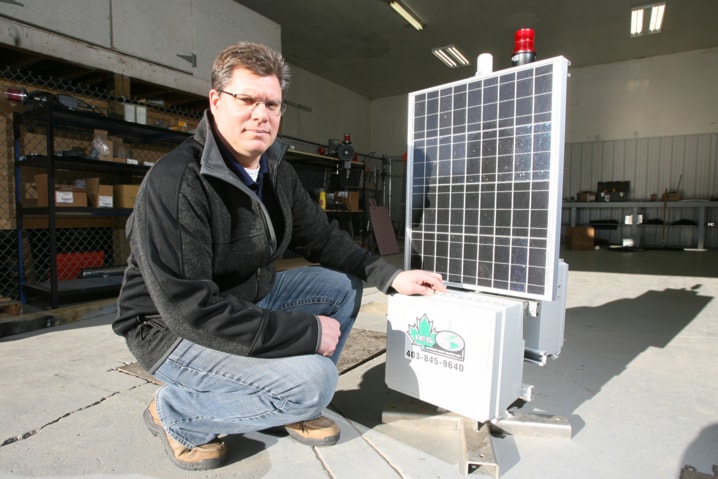Images of workers cleaning up the black chemical soup that spewed from an Innisfail-area pumpjack on Jan. 13 have given critics of hydraulic fracturing compelling new ammunition.
But industry and regulatory officials maintain that “fracking” — the use of a high-pressure mix of water, sand and chemicals to force oil and methane from underground formations — is being conducted responsibly.
“A lot of these situations, you’ve got people with a lease that are doing (fracking) in an area where they’ve got other wells that they own,” said Travis Davies, a spokesperson with the Canadian Association of Petroleum Producers. “They certainly want to make sure that their folks are protected and the public is.”
Brad Turner is president of Independent Energy Solutions Corp., a Rocky Mountain House company that produces a variety of monitoring equipment, including a system that can measure pressure changes in wellbores near fracking operations. Any deviation from a baseline range, which would occur if pressurized fluids entered the wellbore, is communicated electronically to the fracking site.
“There are oil companies out there using very proactive tools,” said Turner, adding that Independent Energy Solutions’ Surefrac Safety System is just one of the options on the market.
Turner has been dealing with international producers and his phone keeps ringing.
“We’ve gotten a lot of interest lately.”
Alberta’s Energy Resources Conservation Board does not mandate the use of monitoring equipment on fracs. Instead, said ERCB spokesperson Cara Tobin, it places the onus on the energy companies it licenses to ensure problems don’t arise.
“How they do that, as long as they’re doing so within the rules and regulations, then they can choose to use new technologies,” said Tobin. “That’s really up to each individual company.”
ERCB records indicate that there have been four other reported incidents of fracking fluids breaching nearby petroleum wells in Alberta since 2008. Two occurred near Rocky, on March 17, 2011, and Dec. 9, 2010, while the others were east of Drayton Valley on Sept. 24, 2011, and between Grande Prairie and the B.C. border on Oct. 19, 2009.
On Monday, the ERCB issued a bulletin stressing that it’s the responsibility of producers to control their fracs. It emphasized the importance of careful planning, including noting the location of nearby wellbores and alerting their operators, and taking into account geological conditions.
“Obviously, industry pays attention to any bulletin by the board,” said Davies of the impact of such communications.
He added that the agency’s policy of holding producers accountable for their end results rather than imposing specific operational requirements makes sense.
“It depends a lot on what the reservoir is like and what the other development in the area are like.”
When adverse incidents like the one near Innisfail do occur, said Davies, producers assess and modify their practices.
“For the industry, there’s a learning curve,” he said, “as with the regulator.”
It’s the steepness of that learning curve that worries Matt Horne, acting director of climate change with the Pembina Institute — a Canadian non-profit think tank that promotes environmental sustainability.
“You’re looking at such high pressures and relatively big unknowns when you’re operating that deep underground,” said Horne.
He believes the Innisfail-area mishap and others that have occurred in Alberta and British Columbia are signals that we need to review fracking processes and procedures.
“I think there’s a role for regulators to be more proactive and on top of the potential interactions between different oil and gas operations.”
The Alberta Surface Rights Group goes further. It’s calling on the Alberta government to impose an immediate moratorium on “high-pressure, multi-stage hydraulic fracturing” — citing the risk of cross-contamination between wells but also of fracking fluids penetrating groundwater reservoirs.
Don Bester, an Innisfail-area farmer and president of the Alberta Surface Rights Group, said the Jan. 13 fluid leak could have been much worse.
“If instead of a pumpjack well it had been a sour well and we blew sour gas out at 5 o’clock or 5:30 at night, and nobody noticed it, the potential for H2S to walk into a farmstead is absolutely going to happen.”
He added that there are decades-old wellbores in Alberta that the ERCB may not even have a record of.
The ERCB’s Tobin dismisses the danger of hydraulic fracking operations impacting groundwater.
“It’s hundreds and hundreds of metres below the base of groundwater protection,” she said. “So these deep fracturing operations are really nowhere near non-saline aquifers above the base of groundwater protection.”
Bester disagrees, arguing that the geological layers are connected by naturally occurring fractures through which pressurized fluids could pass.
There have been no confirmed cases in Alberta of a water well being affected by fracking, said Tobin. But Horne pointed to evidence from the United States of methane migrating upward through zones and reaching groundwater.
Still, he thinks a moratorium on hydraulic fracking is unrealistic.
“I don’t see how you could feasibly pull that off, given how much energy is being produced already relying on hydraulic fracturing.”
It makes more sense, suggested Horne, to seek to better understand the science and improve management techniques.
Independent Energy Solutions already has a monitoring system that can detect hydrocarbons in water wells, which Turner thinks could help smooth the relationship between energy companies and landowners. He believes the use of such technology will one day be mandated by regulators like the ERCB.
“I think it’s coming.”
hrichards@www.reddeeradvocate.com
